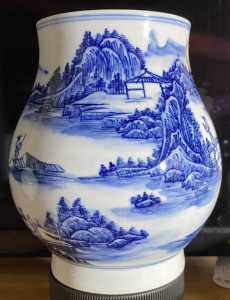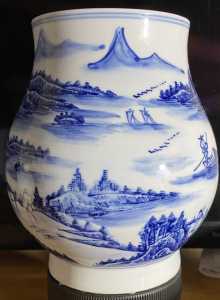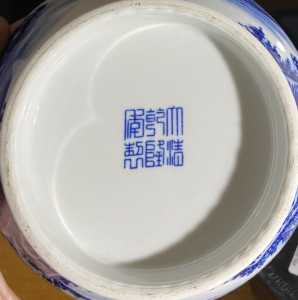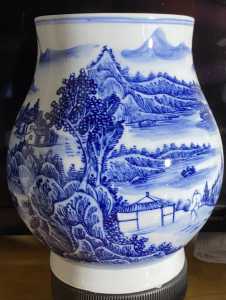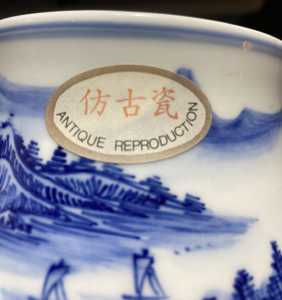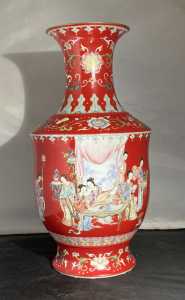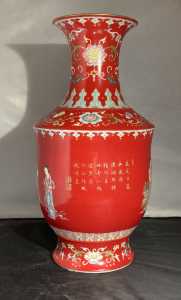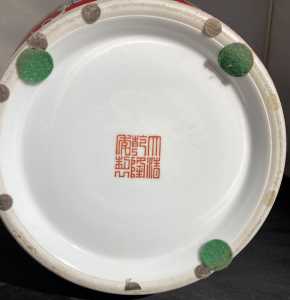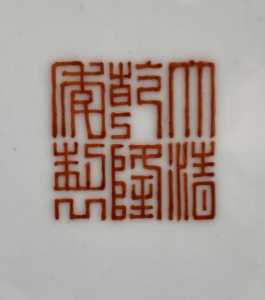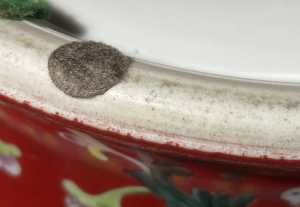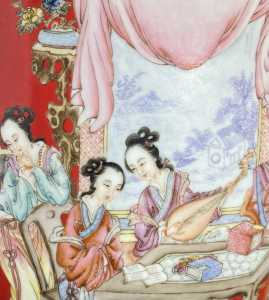The Chinese and Asian Art Forum. For Fans, Collectors and Dealers.
 Basic Rules For the BidAmount Asian Art Forum: Talk about whatever you want. You can even discuss and offer things that are for sale if they are authentic. Maximum image file size per post is 2 MB. Images of 700pxl x 700pxl are optimal if saved at a medium resolution. Be respectful of others and enjoy yourself. Click the YouTube link for a brief tutorial on using the forum. You can also EMBED Videos by cutting and pasting from You-Tube, Vimeo etc.
Basic Rules For the BidAmount Asian Art Forum: Talk about whatever you want. You can even discuss and offer things that are for sale if they are authentic. Maximum image file size per post is 2 MB. Images of 700pxl x 700pxl are optimal if saved at a medium resolution. Be respectful of others and enjoy yourself. Click the YouTube link for a brief tutorial on using the forum. You can also EMBED Videos by cutting and pasting from You-Tube, Vimeo etc.
NOTE: To post an item or add a new post, click open the category title from the FORUM LIST, and CLICK the Blue ADD TOPIC button.
I have been wanting to open a discussion on Antique Reproductions. One of the reasons for this topic to be discussed is because the Chinese market is changing. Quality porcelain is becoming more harder to find and the cost is sometimes out of reach for the common collector. I have also noticed very high quantity reproductions in China selling well over a $1000 bucks. Aren’t high quality reproductions art also. I want everyone to share their reproduction. Or any information you might have on the topic. Lately I have been selling a lot of modern pieces so the market does except reproductions. And for a good quality reproduction I have seen serious offers. Has anyone else noticed this trend? Here is a reproduction I own I don’t know when it was made but it’s label accordingly. I’m also interested when reproductions started and we’re sold as such. Thanks
Brian,
Regarding your request to share reproductions, I'll post some pics of a rather exceptionally made repro...probably fairly modern (last 20 years), but it's so good that I'm sure it could pass as a very fine Republic piece.
Why are people buying reproductions?
If you're theory is that there are speculators hoping to cash in 100 years down the road.... I don't buy it. I really don't think that is how the art market works.
There may be a few decorators willing to pay for good looking copies that they can turn into lamps for a few hundred dollars, but I suspect any high bids being made are from buyers that have more money than sense.
We all have a personal threshold as to what we'd be willing to gamble on a 'possible' genuine piece, so I suspect that a few time that you've gone and sold a modern piece and it sold for a suprising amount, that the buyer was working off of misinformation, and simply believed the piece was older than you claimed.
To be specific to your blue and white landscape hu vase with Qianlong mark.... there is no one with any serious knowledge of Qianlong wares that would believe that your vase has value, or in the future could gain value as a collectible. It's commercial in its rendering with an unrealistic Qianlong mark.
Now, could a person working off of misinformation believe your vase could be Republic or of the period? Yes to both! And, you could get someone who might gamble $500 in hopes of buying a lost treasure...., but that would be a loosing bet.
It is not unethical to sell modern/decorative items at an appropriate price. However, one could argue that the buyers out there working on misinformation and buying modern fakes/copies are victims (perhaps do to their own fault for ignoring good advice) and are being unfairly fleeced of their hard earned money. You wouldn't sell a known gambling addict lottery tickets, would you?
Many years ago I put a beautiful large cinnabar box up for sale at a local auction, only the box was a modern resin copy. You couldn't tell by the photos, so I insisted that the auction house put an estimate of $50-75 estimate and told them not to use the words antique, cinnabar, or lacquer.
The local market I was selling in has plenty of decorators that were quite interested in the box for its aesthetics, not because it was old. But, wouldn't you know it....two people doing online bidding ignored all ther red flags and bid the stupid box to $7,000.
After the sale, I asked the auction house to call the buyer and advise him that the box is not genuine, just a resin copy, and to let him off the hook by having him pay $150 for the box. The auction house refused.
The end result was months of litigation between the buyer and the auction house, and the auction house lost. How you ask?
Well, during the streaming live sale, the auctioneer said the piece was cinnabar....whoops! And since this was not true, there was grounds for suit.
The moral of the story is to be honest with yourself first, and don't let other people's ignorance poison you into doing something unethical.
There is no growing demand for more fakes in this world.
@greeno107 Tim I have to disagree with your statement. I see modern vases selling for $250 to $500 all the time. And are labeled as such. The younger generation actually prefers paying less but still have a nice decor piece. I work with plenty of home designers and the housing market is booming. So Im having a hard time with your statement that some misinformed buyer was taken advantage of for paying a fare market rate. I think the labeling is pretty clear it’s a antique reproduction. Now for you not seeing modern piece as a art form because it is not rendered the way you prefer changes nothing art is in the eye of the beholder.
We all know the Chinese have a long tradition of copying and/or interpreting the wares of the past. Kangxi potters were slapping Ming marks on boatloads of blue and white porcelain. I know there are modern Chinese potters with great skill sets, but unfortunately they seem to be concentrating on reproduction/faking activities because that’s where the most profit is to be found.
I wonder why the Chinese ceramic industry never developed the business organizations that are equivalent to Meissen, Sevres, or Wedgwood. These western companies produce a range of historic interpretive wares and modern designs without falling into the trap of fakery. For example, I just purchased a Meissen vase in the Ming Dragon pattern in the black color way that was probably produced about 20 years ago. The vase is hand painted and in my opinion has artistic merit.
Does anyone know of a “Chinese Meissen” that is marketing high quality wares that are building on the artistic traditions of the past to advance the future of Chinese porcelain? I would love to know about them.
Reproductions basically are copies and as such have been around as long as there have been people able to copy successful creations for their own economic benefit. However, within that there are clearly levels of attractiveness or skill which may mirror levels or economic risk, status or aspiration/intention of the producer. Basically there are the high-end fakes which are beautifully done and the lesser quality knock-offs which in my opinion are akin to the "designer" sunglasses and fake cds that used to be sold on busy streets, fairs, beaches.
There is also the question of deception to a greater or lesser extent. At the top there are high quality fakes intended to deceive, that are marketed with that clear purpose, often successfully fooling experienced collectors. Good quality reproductions differ because they are sold as such, so we can talk more of their being examples of imitation being the sincerest form of flattery. Those are the pieces that get bought by people who want the look, but either can't or don't want to pay the price of genuine articles. They may also prefer new things or it as be that genuine pieces can be hard to find so a good reproduction can give the "instant gratification" that society has learnt to enjoy - and an openly repro piece avoids the accusation that you have been duped!
That leaves the poorer quality copies. A while back, I posted a vase of this type and asked who may have made it and why. It was clearly a poor copy, not worth more than I sold it for but most people were too interested in saying how awful it to discuss what I had asked. The point I wanted to explore was why make such a horrible copy? Some are so awful that one questions the artistic capabilities of those doing the decorating! Yet, since these exist, there must be or have been a market. I can only assume that they are produced to fool the lower-level or more novice collector who has as yet no understanding (we have all been there, I am sure) of the qualities to look for; or they are made for the broader ie including the unregulated street vendor type, tourist market. These are the ones that I see as being the porcelain equivalent of the fake sunglasses. Cheap, disposable, but there is a market and as Sharon mentioned these pieces put food on the table for many people. That was what I found really interesting: the socio-economic conditions of that kind of production and possibly, whether that group mirrors the purchasing group on various levels.
One might also consider contemporary reproductions of say 18th c Chinese porcelain that was made in Europe. These were reproductions, meant to emulate rather than deceive but now they are desirable objects in their own right, sometimes more valuable than the pieces they copied.
At the end of the day, good or bad, these are all copies, maybe the interesting part is that using the term reproduction gives the object legitimacy. It gives it an honest position in the market. I have purchased modern decorative reproductions occasionally, but generally I don't like them because I prefer old things even if they are cracked and worn. It follows, of course, that I have no objection to having old reproductions eg Kangxi revival pieces. So yes, it does leave one wondering what the status of any excellent copy made these days will be in years to come.
In books you usually read the definition „reproductions are made out of reverence, fakes are made to deceive“. It’s not as simple as that, at least not today with the world wide market and the Chinese churning out more copies/fakes than ever. A copy can turn into a fake easily on its way through the world. Just remove the „reproduction“ label from Tim‘s vase or add some grime to the foot of something else.
I remember Tam (who unfortunately hasn’t been active here for a while) saying that middle class Chinese buy the good reproductions for decoration purposes. Sometimes they find their way to the West or are sold out of China by unscrupulous sellers, and then the trouble starts.
As to the bad quality: there’s for example this seller whose stuff can’t even be called copy because it’s pure fancy. They used to have more porcelain and called it „probably 19th century“ but have restrained a bit now. As you can buy them for €30 nobody would think them authentic. (Though they still say „traces of age“ and put them in the pre 1945 category.) But they keep on selling these ugly things, so there must be people who just want to have something Chinese they can afford.
Birgit
Yes, reproductions really are a fluid, murky area. Fine if you know what you are getting, but not if you are deliberately deceived whether by producer or a later owner/seller. It really is a case of buyer beware.
Education is clearly key but this is not an easy subject to master and it is made harder by the online markets being awash with horrible pieces that sellers, whether deliberately, naively or opportunistically think they can make ask ridiculous prices for. It perpetuates and exacerbates the whole problem.
I thought the question Brian was trying to explore was if these high end reproduction pieces were in fact good quality in their own right? I would imagine they are produced differently from the originals, but perhaps someone with more knowledge can explain, because I would be curious to know the difference in production methods, quality of materials, etc.
The intent to deceive is the difference and this falls solely on the seller. We all know there are fakes of almost all things of value. It’s only when aging has been added that the item is no longer a reproduction or copy and now is a fake. I buy reproductions for many reasons I like to put them outside in my gardens some I use for candy dishes I have lots of animals so I’m not leaving 200 year old porcelain to be broken by my frisky cats. But maybe I’m different because I’m a working artist I believe even a modern copy is art. Good quality or bad someone is creating it to be admired. One would say a poor quality copy I don’t see it that way I’m just not wired like that I feel artistically there is a place for it. When I sell something modern I alway try to make it clear and I have never gotten two buyer or a designer to get into bidding wars. But for most just offering a refund and correct information is all that’s needed. I or anyone can’t police the piece after a sell that’s why Sotheby’s is in business.
I'm not saying that a modern copy can not be attractive or artist in its rendering. But, when it comes to Chinese porcelains, the common thread between the objects value and the artistry is how well does it represent the style of the period it was made, hence mark and period porcelains always garner higher values than non-mark and period vases.
When we consider 'revival' porcelains, there needs to be an overwhelming and widespread desire amount contemporary collectors to own said style, that they will buy modern copies of porcelains in that style for the purpose of personal enjoyment. Whether or not at a later time in history those 'revival' porcelains go up in value really depends on the taste of future collectors, and not so much on the quality of the work. For example, you don't see much demand for Egyptian revival wares since around 1970-80, but genuine period Egyptian artifacts hold their value.
But what is happening in the modern porcelain market today is not driven by a younger population of collectors looking for affordable representations of any particular style of antique porcelain (as you'd expect in a revival movement), but rather the massive attempt to recreate similar looking porcelains to genuine antiques that deceive (or perhaps tempt) unwary buyers into the hopes of finding a lost treasure. These modern copies are not revival, nor are they art.
Now, if the modern artist encompasses new techniques, or variations that distinguish the piece from past styles, and by chance creates a beautiful rendering that in its own merits is worthy of being called art, then perhaps that is the exception to my theory, but I suspect that is few and far between.
Now, if you want to see a great looking copy.... take a look at this! The rendering of the scene is highly detailed. The porcelain is pure milk white. And let me tell you that the foot ring is so smooth that it would classify as 'baby skin', a trait of genuine imperial porcelains of the 18th c. Enjoy!
I think that is it: the items that will do well over the course of time will be the pieces that use quality porcelain and skilled artistry to capture the essence of what made earlier pieces so wonderful. It won't be the ones that seek to emulate signs of aging but the pieces that are inspired by originals without seeking to recreate them exactly. But are those really reproductions? They seem to be more like modern interpretations of previous styles.
I wonder how this new age will be referred to by future collectors?
@greeno107 Your vase has a republic look. If modern it’s a quality vase. One thing I have always struggled with is people deciding what is a piece of art and what is not. Most people couldn’t form a pot let alone paint one. Most pottery artist ancient or modern spend a life time learning the skills needed to create a piece. If it was easy everyone one would do it. The Navajo create rugs in the Chieftains style to this day stitch by stitch. Their rugs sell for thousands and are considered artworks. So why shouldn’t a potter from China receive the same treatment.
@lotusblack It's been a while since I took art and philosophy courses in college, but let me pose my thoughts first in a form of a question.
If everything is art, and anybody can create art, then what makes art special?
Artistic ability is the method that a very few people are able to capture something intangible (history, philosophy, culture, light vs. dark, good vs. evil, religion etc....etc...) and transforms it into something tangible (art) that most everyone can recognize, if not appreciate.
Maurizio Cattelan taped a banana to the wall, and a good argument could be made that it is art, because Cattelan was the first to do it, and because he was using a unique media to convey the message of how changing the context of simple objects can create meaning. The piece sold for $120,000.
However, I can tape 100's of bananas to walls just as well as Cattelan did, but it's not art, and there is no justification for anyone to pay me a penny more than the cost of the tape and banana.
@greeno107 This vase is surely of high quality but is nevertheless a fake in my opinion. The faces have that pseudo 1940s look you so often find today and don’t go together with the rest of the decoration. You wonder what period the painter was actually trying to copy. It’s a pity they don’t apply their skills to something better.
In Taiwan I indeed encountered porcelain painted by modern artists but it was out of my financial reach.
Birgit
Thanks for visiting "The BidAmount Asian Art Forum | Chinese Art"
If you sell on eBay, or have a shop feel free to post images and descriptions and links.
Check back often for discussion about the latest news in the Chinese art and antique world. Also find out about the latest Asian art auctions at Sotheby's, Christie's, Bonhams and Tajans.
Auction results for: fine porcelain, ceramics, bronze, jade, textiles and scholar's objects. As well as Japanese, Thai, Vietnamese and other Asian cultures.
Thank you,
Peter Combs
Topics and categories on The BidAmount Asian Art Forum | Chinese Art
Kangxi vases, Kangxi dishes and chargers, Kangxi ritual pieces, Kangxi scholar's objects, Qianlong famille rose, Qianlong enamels, Qianlong period paintings, Qianlong Emporer's court, Fine porcelain of the Yongzheng period. Chinese imperial art, Ming porcelain including Jiajing, Wanli, Xuande, Chenghua as well as Ming jades and bronzes.
The BidAmount Asian Art Forum | Chinese Art
A free Asian art discussion board and Asian art message board for dealers and collectors of art and antiques from China, Japan, Korea, Thailand, Cambodia, Vietnam and the rest of Asia. Linked to all of the BidAmount Asian art reference areas, with videos from plcombs Asian Art and Bidamount on YouTube. Sign up also for the weekly BidAmount newsletter and catalogs of active eBay listing of Chinese porcelain, bronze, jades, robes, and paintings.
The art of calligraphy - and for the ancient Chinese it certainly was an art - aimed to demonstrate superior control and skill using brush and ink. Calligraphy established itself as one of the major Chinese art forms during the Han dynasty (206 BCE - 220 CE), and for two millennia after, all educated men were expected to be proficient at it.
The Museum’s collections of Asian art span nearly five millennia and encompass the cultures of China, the Himalayas, India, Japan, Korea, and Southeast Asia. In 2007, the Museum launched an initiative to create dedicated galleries for the collection, beginning with a gallery for the arts of Korea ...
Chinese art is full of symbolism, in that artists typically seek to depict some aspect of a totality of which they are intuitively aware.
China Online Museum is the finest online museum of Chinese art. It features Chinese calligraphy, painting, ceramics, bronzes, carving, and other artworks.
Chinese Ceramics & Works of Art. Overview Upcoming auctions Contacts Auction results ... Christie’s sales of Chinese ceramics and works of art showcase centuries of Chinese history. Held throughout the year in London, New York, Paris and Hong Kong, they attract a wide audience of collectors and connoisseurs vying for pieces as diverse as ...
Explore Asian Art Week. Contact the Specialist Department. Chinese Paintings ... Senior Specialist, Head of Sale. [email protected]. Tel:+1 212 641 5760. Bid in-person or online for the upcoming auction:Fine Chinese Paintings on 10 September 2019 at New York. Bid in-person or online for the upcoming auction:Fine Chinese Paintings on 10 ...
Discover an abundance of must-see art from all corners of a vast continent at Christie’s NY Asian Art Week. From contemporary classical and Chinese paintings to works with exemplary provenance from the Art Institute of Chicago, our Rockefeller Paza galleries will be full of ancient treasures and contemporary masterworks in a salute to the vibrant arts of Asia.
Sold to benefit The Art Institute of Chicago’s Asian Art Acquisition Fund, the sale features 84 lots with a focus on Ming and Qing porcelains, and offers a rare insight into the taste for collecting Chinese ceramics and works of art in the Midwest from the end of the 19th century through the 1980s. Highlights include two Wanli wucai garlic-head vases, a Qianlong mark and period, blue and ...
Specialist, Chinese Paintings, Christie's London Dr Malcolm McNeill is a Specialist in Chinese Paintings at Christie’s, based in London. He previously worked as an assistant curator of the Chinese collections and the Victoria and Albert Museum in London, as a researcher at the British Museum, and as a translator and tour guide at the National Palace Museum in Taipei.
The Christie's Education 2020 Conference: The Chinese Art Market 18 Jun 2019 Christie’s Education is delighted to announce our first international academic conference in Asia which will take place in Hong Kong from 26-27 November 2020 at the Hong Kong Convention and Exhibition Centre and will run in parallel with Christie’s Hong Kong Autumn Auctions.
The summer Chinese Art sale in Hong Kong will feature works of art from several private collections, including Qing porcelains and textile from the collection of the legendary Chinese art dealer A. W. Bahr (1877–1959), fine gilt bronze Buddhist sculptures from an old Hong Kong collection, an East Asian collection of Qing dynasty wine cups and jades, and a Japanese collection of Song ceramics ...
Sotheby's Chinese Works of Art Department holds two auctions each year in London, New York, Hong Kong and Paris.
Chinese Art - View Auction details, bid, buy and collect the various artworks at Sothebys Art Auction House.
With more than 340 Chinese works of art dating from the Neolithic to the Republic periods, highlights of this sale include a selection of Qing Imperial monochromes from the collection of Arnold and Blema Steinberg, early ceramics from the Art Institute of Chicago and Chinese porcelain and works of art from the collection of Henry Arnhold.
Results: Sotheby's Asia Week achieved $52.4 million in six strong auctions, exceeding pre-sale estimates. With 76.5% of lots sold and 60.3% of lots surpassing high estimates, the Asian art sales at Sotheby's indicate continued collector interest in the finest works of art from China, India and and the Himalayas.
Today's sale of Important Chinese Art will proceed as planned with sessions at 10 AM and 2 PM EDT. Sotheby's will be monitoring the weather conditions throughout the day and will be available to coordinate alternative bidding options should conditions make it difficult for clients to attend the auction in person.
Bonhams Chinese Art department is renowned for offering the finest works of art representing the richness and breadth of China's artistic heritage, particularly Imperial porcelain, white and spinach green jades, cloisonné and Buddhist art. Specialised international auctions are held globally, including London, Hong Kong and San Francisco.
Bonhams : Chinese Works of Art We use cookies to remember choices you make on functionality and personal features to enhance your experience to our site. By continuing to use our site you consent to the use of cookies. Please refer to our privacy and cookie policies for more information.
Bonhams Fine Art Auctioneers & Valuers: auctioneers of art, pictures, collectables and motor cars. We use cookies to remember choices you make on functionality and personal features to enhance your experience to our site. By continuing to use our site you consent to the use of cookies. ... Chinese Art (US) General enquiries
Bonhams : Fine Chinese Art We use cookies to remember choices you make on functionality and personal features to enhance your experience to our site. By continuing to use our site you consent to the use of cookies. Please refer to our privacy and cookie policies for more information.
Bonhams Fine Art Auctioneers & Valuers: auctioneers of art, pictures, collectables and motor cars Bonhams : Asian Art We use cookies to remember choices you make on functionality and personal features to enhance your experience to our site.
Bonhams are international auctioneers of fine Chinese and Japanese art. We specialise in rare Imperial and Export Chinese ceramics and works of art, as well as Japanese ceramics, fine and decorative works of art from the Neolithic Period to the 20th century. View on map
Bonhams Fine Art Auctioneers & Valuers: auctioneers of art, pictures, collectables and motor cars. We use cookies to remember choices you make on functionality and personal features to enhance your experience to our site. By continuing to use our site you consent to the use of cookies. ... Asian Art Bonhams. Work. 22 Queen St.
